 Facebook
Facebook
 X
X
 Instagram
Instagram
 TikTok
TikTok
 Youtube
Youtube
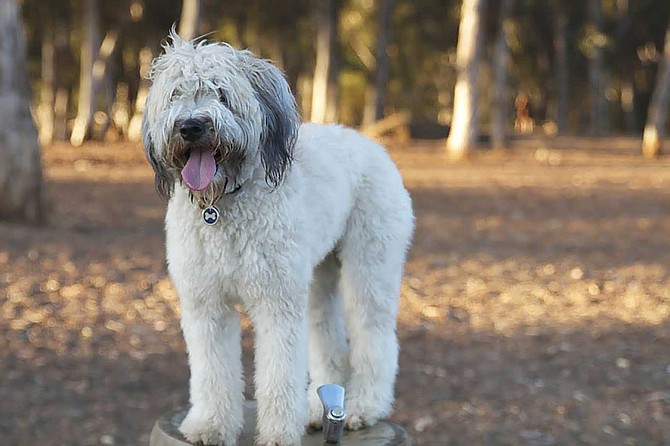
My dog has a favorite bar. Loki quickly learned how to navigate the blocks to Hamilton’s Tavern, and if I let her control the leash on our afternoon walks in South Park, that’s where she led me. She even nudges at the door to urge me in for a pint. I’m not sure if that’s a trick I taught her, or the other way around.
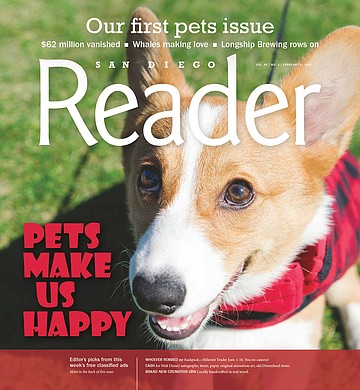
When we go inside, people know her, like she’s Norm walking into Cheers. The owner, bartenders, regular customers greet her by name — Loki! —and she reacts to the welcome with excitement. But here’s the weird part: a lot of these people, I don’t know them. Complete strangers often walk toward me, only to crouch down at the last moment to hug and kiss the floppy, fluffy, 40-pound lapdog at my feet. “Loki, darling,” they’ll say, “it’s been too long!”
Turns out, Loki spends more time here than I do. That’s because it’s my ex-girlfriend’s favorite bar, and we agreed to share it when we split up. More importantly, we did the same with the dog. Against sound judgment and the advice of mutual friends, for the past eight years we’ve shared custody of Loki. We pass the pooch back and forth each week. We split costs and health care decisions. And it’s worked out.
Nine years ago, we moved into a dog-friendly rental together, in love and eager to get a puppy. We found a hypo-allergenic wheaten terrier and poodle mix. Loki, named for the dog of mischief, is a charmer. She’s playful and affectionate, and loves to communicate. With her shaggy face, imploring brown eyes, and quizzical head tilts, she usually wants to communicate that whatever you’re doing, she’s in. Whether it’s running around the beach or napping on the couch, she will join you.
That first year, we all lived together happily as Loki’s puppy coat went through the wheaten terrier color changes: starting out dark brown, turning orange, and landing on some shade of wheat. That was about the time our dog-friendly lease ran out, and going month-to-month wasn’t an option. We’d been butting heads on big-picture issues; we weren’t sure we wanted to split up, but we couldn’t commit to another 12-month lease.
We’d each bonded so strongly with the dog, neither would willingly give her up. And neither were we angry enough not to recognize how much we both meant to the dog. Not sharing custody seemed cruel.
So, Loki found herself with two homes, two domains to defend, two front doors to bark at when guests arrive. We fed her the same food and treats, made sure we both had a version of the same favorite toy. The only things that travel back and forth with her are her collar and a leash.
When my ex picks up Loki from my house, Loki will wag her tail and rush out like she’s got somewhere important to be. But when I pick up my dog a week later, she’s just as ecstatic, and leaps into the backseat of my car, ready for the next adventure.
I definitely miss my dog the weeks she’s not around. She’s not there to greet me at the door when I get home, or nuzzled against my feet when I wake up in the morning. She becomes a phantom sidekick I can’t bend down to pet. But there’s an upside. I can leave town for a week, and Loki has no idea. I never have to pay a pet sitter. Loki’s well taken care of, even when I don’t have time.
There have been a few disagreements, but in working together to care for a pet, the Ex and I have managed to remain friends. In fact, when she moved out of her dog-friendly one-bedroom apartment, I moved in. It was almost like Loki got a new roommate.
Our afternoon walks no longer take us to Hamilton’s. Instead, Loki pulls the leash to show me all her favorite pee spots in Golden Hill. And just like that, I learn something new about my dog of nine years. Over hundreds of walks in South Park, she always peed once and was done; she never held any to mark territory along the way. But in Golden Hill she always stops to sniff and mark five specific street corners. As she apparently has for most of her life.
— Ian Anderson

It was late June when I found August — all matted fur and skin and bones. He was in a strip mall parking lot off of Kenwood Drive in Spring Valley. Only a chain link fence separated him from the 94 freeway. A bearded man on a flimsy folding chair outside a nearby smoke shop told me August had been there for over a week. “Someone from the apartment complex across the street dumped him when they moved. It happens. A few people have tried to catch him, but he is slippery,” Bearded explained.
A woman missing a tooth in the center of her smile pulled over when she saw August darting through traffic. Like me, she was concerned.
“He yours?” she asked.
I shook my head, prompting her to stuff two bone-thin fingers into her mouth to whistle in much the same manner as the lunch ladies at my my elementary school did when kids got too rowdy.
“Here puppy! That’s a good doggy,” She cooed in a deep husky voice.
August paused in his tracks, tilted his furry little head, and looked up at her with his sharp auburn eyes before bolting up the street. As he weaved in and out of traffic, I squeezed my eyes shut for fear of witnessing the carnage. Missing Tooth leaned her skinny behind against the hood of her dusty sedan and let out a worried sigh.
“I am not going to panic,” she declared, “He’ll come to me. He won’t got squashed. He will not get squashed!”
Minutes later, August ran a circle around the parking lot. He stopped and looked up at her in an almost taunting manner.
“That’s a good boy,” she cooed.
He came close and sniffed her feet before darting behind a dumpster.
“Get on the other side of that dumpster!” the woman barked, “We can trap him.”
As I moved to one side of the dumpster, I heard from the other, “I got him!” Missing Tooth held August up — a living trophy of her perseverance.
August looked more like a tiny fox than a dog. He was surprisingly docile. He didn’t attempt to wiggle free.
“Feel his little paws,” she said, placing a furry foot into the palm of my hand. It was scorching.
“He has been running so much, I am surprised his little paws didn’t set fire,” the lady added with a soft smile while petting August’s matted fur. His tail was smeared in feces.
She turned to me, adding abruptly, “I can’t keep him. You are going to have to take him,” she pushed the stinky dog into my arms. Noticing my hesitation, she added, “He certainly can’t stay here. He will die! He’s hungry and he’ll get squished. I have four dogs at home. My boyfriend will murder me if I come home with another.”
The man in front of the smoke shop was watching to see what I’d do. I looked at the woman and down at August. He nuzzled sweetly into my shoulder and licked my arm. The woman went over to my car and opened the back door. I set August down, expecting him to run. He didn’t. He jumped into the front seat and nestled down.
“Well, look at that!” she said.
“Free filthy mutt,” the man from the smoke shop yelled with a cackling laugh.
When I pulled out of the parking lot, August climbed onto my lap and looked up at me with sad eyes. I loved him immediately. He needed me. So I took him home and bathed him in my yard until the water running off his fur was no longer brown and his little paws were soft and cool.
— Siobhan Braun
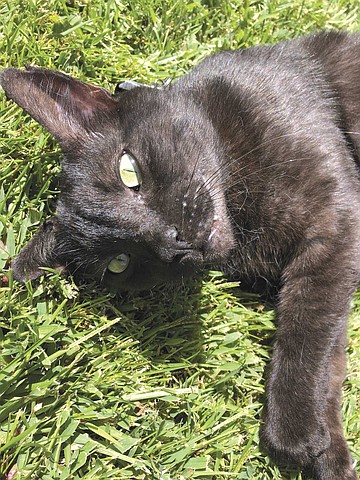
He’s a mysterious looking black feline named Hawke, and he immigrated from Canada a few months ago with his owners, my neighbors. Within days of moving in, they gave all the neighbors a photo of their cats so people would be aware.
Hawke was described as “a bit chubby, but very friendly with everyone,” while the other cat, Edie, “can be frightened a bit easy,” but is “a sucker for cuddles” once she gets to know you.
Hawke is pretty friendly with us, while Edie keeps to herself. Sometimes my wife and I will mention “an Edie sighting.” My wife loves cats, but we haven’t had a pet for a while. Or at least, we didn’t. Remember that part about Hawke being “very friendly with everyone”? Well, he is, but he’s not so good about respecting physical boundaries.
Within a few weeks of being in California, Hawke clawed his way through our back door screen and made himself at home. Now, he comes and goes as he pleases. Somehow, he started sleeping in our bed.
“Can you move over?” my wife will ask me at 2 am.
“Can you tell Hawke?”
“He’s sleeping.”
On the nights when Hawke isn’t here, he will still show up at the back door, politely asking to come in for treats. We bought treats and cat toys. We’re in deep!
Hawke’s boundary issues stretch to the bar separating the kitchen from the dining room. He likes to climb up while we’re making dinner. It’s not always appreciated.
“Hawke’s licking the butter again!”
“Well, get him off the table.”
“I need to scrape off where he was licking.”
The human Canadians are wonderful people who haven’t shown any signs of jealousy, probably because they know we will feed the cats if they go out of town.
Still, I can’t help feeling pangs of guilt, especially when Hawke offers up mice and birds he’s killed as offerings of love.
“Oh my God!” said my son the time Hawke brought a dead dove to the back door.
“Huh?” I asked.
“Look at Hawke!”
And there was the black cat biting off the head of a freshly-killed dove, right before he somehow broke into the breastbone, pulled out the bird’s heart and ate it.
“Wow, nature at work,” I thought.
So I’m not really a cat person, but I’ve heard that you’re supposed to praise them when they bring you dead animals. So there I was, gently lifting the dead bird carcass with the help of a paper towel and walking it to the trashcan on the side of the house while simultaneously buttering up Hawke.
“Oh, you’re such a big killer. Thank you for providing for us. Wow, you really know how to follow those innate feral instincts, don’t you?”
—Patrick Henderson
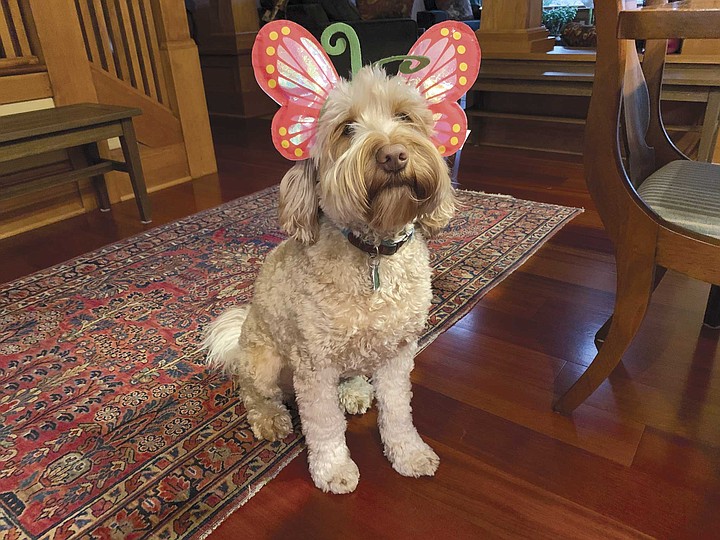
It wasn’t a promising relationship at first. He was a dog. I hated dogs, though I would never say that out loud. No one is allowed to hate dogs. But my husband Mtume and I did. In public, we said, “We’re not dog people.” To each other we said, “Ugh. I hate dogs. They’re disgusting. Dirty sh*t machines.”
One dog person in my family didn’t seem to understand (or care) about the whole “not dog people” thing, and we had to say no to the pooch every single time said relation came to visit. When you have to keep saying ‘No, please don’t bring your dog,’ you begin to wonder if you’re a bad human. It’s annoying. “Ugh,” Mtume and I would say to each other. “Why do dog people think everyone should love dogs?”
But then my mom got a puppy. A labradoodle she named Beau. When he was about five months old, she asked me to come to Boise to stay with him while she went to her annual five-day silent retreat in the mountains. The way she presented it, she was inviting me to bask in some luxurious me-time at her house, on her dime. All I’d have to do was feed her puppy and take him to the dog park a couple of times. It didn’t sound terrible, so I agreed to do it.
My daughter told me dogs’ eye muscles have evolved to enable expressions that trigger human emotions. I looked it up. It appears to be true. I could certainly feel it working on me. Every morning, I came down the stairs and found Beau at the door of his kennel, looking like Little Mister Perfect with his back straight, “being good” and hoping to be noticed for it. Our eyes locked, and I could feel the serotonin, prolactin, and oxytocin coursing through my bloodstream. There was nothing I could do about it. He made me love him.
He made me love the way his ears flop around. And the way he comes galumphing at full speed toward me at the dog park, only to make a quick, last-second fakeout to the left. He made me love the cooing sound he makes when we play-fight on the living room floor. It’s to be expected, I think, that a person would fall in love with a dog. It’s evolution. But Beau did more than make me love him, he made me love all dogs.
I’m officially dog people now. I stop to pet dogs on the street. I gaze at dogs lovingly from across the park. I applaud dogs in grocery stores and libraries and airports. I sometimes go to Dog Beach just to watch the dogs go bananas in the sand. My mom has a mug that says, “I love dogs. The End.” I want one. The mug, I mean. I want a dog, too, of course. But Mtume says, “Hell no. Not until they make one without an a --hole.”
A plan is in the works, though. Beau is coming for a visit in the spring. He’ll work his magic, and by the time he leaves, Mtume will be dog people, too.
— Elizabeth Salaam

In the fall of 2015, my girlfriend Janelle became ill with what seemed like a nasty case of the flu. After a couple of days of unusually severe symptoms, we took a trip to the ER. The doctors determined that Janelle had pneumonia. The case was bad enough that doctors admitted her for observation overnight. That single night turned into an awful two-week stay that included a dramatic stint in the intensive care unit. She developed a lung disorder known as acute respiratory distress syndrome. After being intubated for a few days, her lungs rebounded.
Her doctors were bewildered as to what could cause a healthy woman in her 30s to fall victim to an illness like that. One theory they came up with was that high stress levels had worn down her immune system. Doctors suggested a variety of stress-relief strategies, one of which would change our lives forever: “Get a pet.”
We had always wanted a dog, but our landlord had a “no pets” policy for our house. So one day, while home on medical leave, Janelle shifted into sales mode and shared her recent plight with our landlord. She explained, with the most earnest of approaches, that a small dog would serve as a sort of semi-service animal for her, highly encouraged by her doctors. A slight increase to our rent was established, and it was a deal.
With ongoing lodging established, the next step was to find the dog. We decided to go the route of rescue, with the assumption that there would be plenty of great dogs looking for their “forever homes.”
We thought it would be a pretty painless process, but adopting a dog was not as simple as going to the local shelter, paying a small fee and taking home a new Fido. For us, dog-adoption involved intensive research, application fees, interviews, competition, and even some initial heartbreak.
Truth be told, we were a bit picky. We both wanted one of those fluffy little dogs, probably some hypoallergenic poodle mix. There were a decent number of them out there, but we weren’t aware of just how many other people were searching the same sites for the same little critters.
After lots of online research and several adoption events, we thought we had found our match when we drove to Clairemont to meet Bailey, a 10-month-old poodle mix Janelle had been eyeing. Bailey had a charming personality and seemed like the perfect object of our love and affection.
There was another woman angling for Bailey, though, and as the morning progressed, she became our archnemesis. At this event, the dogs were available on a first-come, first-served basis, assuming you had the necessary cash. We had arrived early for this exact reason, but the nemesis claimed that she had been there first and essentially latched herself onto the dog — our dog! The nerve. The nemesis’ strategy paid off, and Janelle cried all the way home in the car.
We licked our wounds and continued to search for the perfect pooch.
Soon thereafter, we discovered another adorable ball of fluff on the interwebs. His name was Palmer, and he was currently under the care of foster parents in Orange County. We stalked Palmer online for a spell before we drove to a Petco in Newport Beach for an adoption event. It turned out to be more of a job interview where we had to explain why we would be the perfect pet parents to our dog of choice.
Palmer was just what we were looking for. He was loving, kind, hypoallergenic, and constantly insisted on being picked up and hugged. Bingo!
The issue was that a small child seemed similarly attached to Palmer. I considered roughing up the kid but restrained myself. A couple of days later, we got the call that Palmer was ours. Janelle’s work-from-home gig had sealed the deal, as the five-year-old pooch was apparently a bit on the needy side.
Palmer arrived and was promptly rebranded Georgie Ruff Ruff Martin — a name inspired by my late mother’s devotion to Game Of Thrones.
Georgie has been a loyal dog at our sides and in our bed for nearly four years now. We had no idea how much love we could feel for a fuzzy little buddy. Much like new parents, we can’t even remember what we talked about before he came into our universe. He was a big hit at our wedding a couple years later as well.
Georgie continues to follow us from room to room in the house, and he’s doing his part to keep Janelle’s stress levels low and her lungs healthy.
— Dryw Keltz
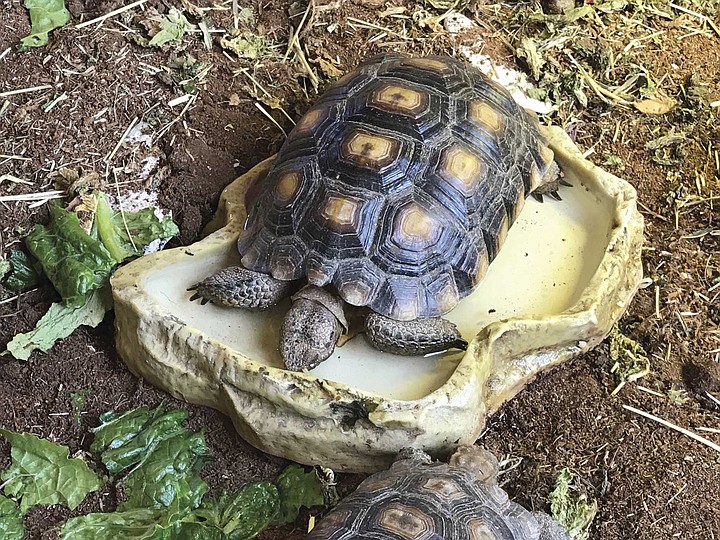
“I’m not sure if they’re even still alive,” Cassie Youngborg said with concern as we walked in her front door. “They haven’t come out since late October.” Cassie’s four pet desert tortoises began their first brumation — similar to hibernation, but for cold-blooded animals — in late autumn 2019; they were still a bit young to exhibit the behavior. We were there to watch them wake up.
Cassie was surprised when the three-and-half-year-old tortoises started digging themselves under the loose dirt in their plywood pen, which she keeps in the sunny front room of her Encinitas home. She consulted her tortoise-keeping pals and they advised her to go with it. So she and her husband built a makeshift burrow of cardboard to keep the young tortoises covered.
Desert tortoises usually begin brumation around age five, when they’re juveniles. Younglings might be too small to maintain body weight for the prolonged rest period. During winter months, certain reptiles drop body temperature and go into a state of torpor until the weather warms up. Unlike mammal hibernation, brumation is not sleep. Tortoises might come out to drink water — though Cherepaha, Rùa, Gui, and Lock Posht (that’s Russian, Vietnamese, Mandarin, and Arabic for turtle) didn’t emerge at all during their first brumation.
Cassie’s four desert tortoises hatched under the care of her friend, Marcel Van Boxtel, whose 45-year-old pair, Taco and Tequila, produce 12-14 eggs every year. She took them home right away and began caring for them as pets, along with her now 37-year-old yellow-naped Amazon parrot and a black lab. Desert tortoises are endangered in the wild, and it is illegal to take one out of the desert, buy, or sell one. It is, however, legal to keep them as pets in California, with a special permit, as long as they are descended from animals that were in captivity before 1990. The San Diego Turtle and Tortoise Society can help with care tips and paperwork.
Cassie’s grandmother Prudence also raised pet turtles at her home in Del Mar. She put a sign on the fence advertising “25¢ a snail.” Neighborhood kids got a quarter for every snail they brought for her tortoises to eat.
“I’ve missed you,” Cassie cooed to the little tortoises as she reached into the burrow to unearth them one by one. They looked healthy. Their shells ranged in size from about six to eight inches. She placed all of them around the pen and sprinkled some fresh lettuce leaves. To our surprise, the first one poked its little head out after just a few seconds.
“Are you hungry? You probably want a drink!” Cassie hurried to put their water dish in the pen and pour in some warm water she had prepared. She picked one up and placed it directly in the dish. As it soaked, the tortoise dipped its head and began to sip. Warm water helps restore body temperature. Cassie gives them spring water or filtered water.
“Now your sister wants a turn.” She put the smallest of the four in the dish. “She has a little underbite,” Cassie pointed out. “She’s the only turtle I’ve seen like that.”
“Hello!” Bob the parrot called from his enclosure in the next room. “Errol, what’re you doing to your brother?!”
Errol is one of the Youngborgs’ children, now adults and moved out. Bob the parrot grew up with them and of course picked up the family chatter. He reminded us of his presence every few minutes with a snappy phrase.
“Hey, baby!”
Outdoors in the front garden, more life flourished. Fat monarch caterpillars munched on milkweed. Cassie grabbed a few leaves of arugula and ate them. She showed us a mature lemongrass plant and feverfew that she chews when she gets a headache.
When we went back inside to check on the tortoises, three of them were favoring one corner of the pen. They looked like they wanted to hide. Cassie rested a blanket over the corner to form a dark place. Sure enough they all crawled under.
“I sing this song when I go to schools to teach the kids about turtles,” she shared as she put her hand into a turtle puppet. “When I get tired, I pull in my head, I pull in my head, and I go to bed.”
— Leorah Gavidor
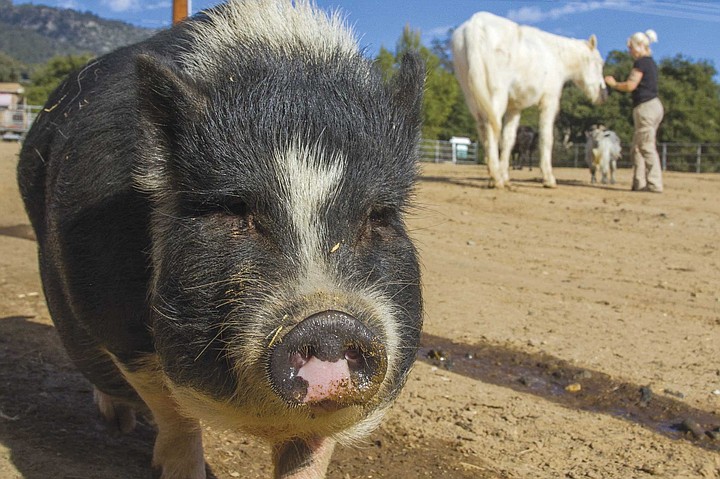
Janice Jordan’s passion is the welfare of her animals. This much becomes clear as we tour her 3.5-acre ranch in the Pauma Valley, about 40 miles northeast of downtown San Diego, where I meet dogs, cats, birds, goats, horses, turtles, ducks, a potbellied pig (Piggie Smalls), a full-sized, half-blind farm pig (Champ), and a pair of wolf dogs.
“We’re an all-species, special-needs animal rescue,” explains Friends of Ferdinand co-director Jordan. “We’re the go-to agency when there’s a special-needs animal, including a puppy we have right now with mega-esophagus, a condition that means he needs to be held upright when he is fed. We work with blind animals, deaf animals, geriatric animals, animals who are missing limbs, ‘attitude animals,’ and others who are just not being adopted.
“We take on anything that humane societies cannot take care of in a shelter. When it comes to special needs, I don’t want people to think just of extremely hard cases where an animal is born without limbs or eyes; the term can encompass any animal that a traditional shelter doesn’t deem adoptable.”
A co-founder of Ferdinand’s Familia, another all-species rescue based in San Diego, Jordan branched off to form Friends of Ferdinand to care for animals needing more specialized or long-term care.
Most of the property’s pens, fenced yards, and other enclosures are home to more than one type of animal. Ducks and turtles share a shady pen surrounded by a stand of trees, while Piggie Smalls is accompanied in his corral by a pair of inquisitive goats and an older horse who seems uninterested in human company.
“When an animal comes to us, they’re immediately introduced to other species. If they’re able to get along with others, that makes them immensely more adoptable, while the ones with the highest euthanasia rates are those who can’t interact with other animals,” Jordan explains. “So here you’ll see the tortoises are with the pigs, the cats interact with dogs, and sometimes birds and rabbits. It makes them more sociable.”
Still, Jordan admits that finding the right adoptive home for an animal with special needs, whether they be issues pertaining to limited mobility, sight problems, or a condition that requires regular medication, is harder than placing a puppy or kitten with a family.
“What I’ve learned is that we really have to work to find the perfect pairing,” Jordan continues. “Most people want an animal that’s not high maintenance. So needing to provide regular medicine, or deal with seizures, or even with an animal that’s just hyperactive and needs a lot of interaction and walks — I wouldn’t push anyone who’s not prepared to take that on.”
— Dave Rice
When it comes to pets, the lion’s share of attention tends to gravitate toward dogs and cats. Smaller furry companions are often easy to overlook.
Likewise, the storefront for Wee Companions — an animal rescue dedicated to small animals such as guinea pigs, rats, mice, hamsters, and chinchillas — is easy to miss. It’s tucked into the back of a University City strip mall between Sprouts and a post office. It takes a moment to locate the entrance after Fenella Speece, the organization’s president, invites me to come by and learn more about the charges under her care.
Speece, a petite, bespectacled Englishwoman, grew up raising guinea pigs before parting with her pets to attend university. Years later, she landed in San Diego as a Navy wife with two children and rekindled her love for small animals after noticing a lone guinea pig at a dog adoption event in Balboa Park.
After learning that rescue options for small pets were limited around the county, she began growing a network of volunteers, and in 2003, she formed Wee Companions. Today, as many as 250 animals are in foster care at any given point in time, with the group facilitating between 1000 and 1200 adoptions annually.
Their goal is to eventually fund a full-time shelter serving small animals exclusively, but for now, the shop is open Saturdays and Wednesday afternoons, when volunteers bring in foster animals to meet potential adoptive families. The space also sells food, toys, and bedding, along with other small pet necessities, while an adjacent property hosts Monte’s Corner, a secondhand shop named after a favorite foster guinea pig, that provides a fundraising avenue to the group.
“People can come in as many times as they want; I love to see that,” Speece says. “They bring their child, handle a guinea pig, then say they’ll be back the next week to meet some more animals. They’re on the hunt for a pet, but they’re taking the time to find the right one.”
“Small animals can be seen as easily disposable animals, and believe it or not, we’ve found them abandoned by dumpsters, in dumpsters, by the pet stores that they were originally purchased from and which can’t take them back,” Speece continues. “The most heartbreaking thing I hear is that small pets are used as ‘starter’ pets. ‘Let’s see if the kids do well, and if they do, then we’ll graduate up to a puppy.’
“Allergies are also an issue — Timothy hay, a type of grass, is a primary component in many small animals’ diet. To ensure a fit, adoptees are sent home with a bundle of hay — to expose not only themselves but other family members — to ensure there are no reactions that might lead to problems post-adoption.”
— Dave Rice
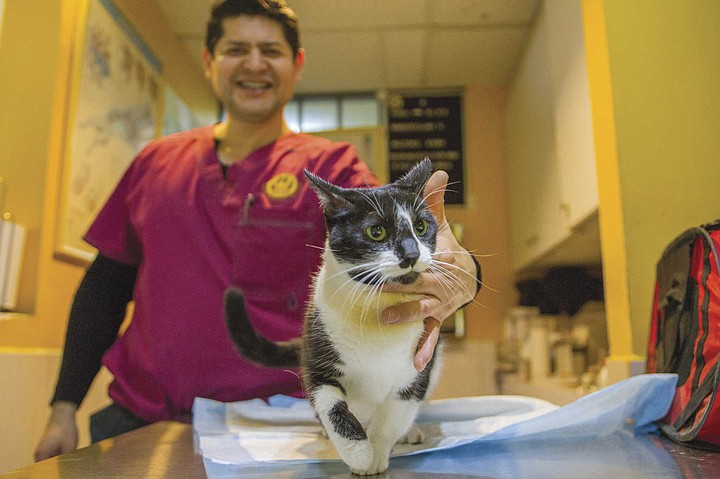
Since I adopted my cat in early 2014, I have been going to the same veterinarian in Tijuana. I adopted “Bisho” through my friend Claudia. She would not give me the kitten unless I promised I would have him neutered and bring him to a vet regularly. She recommended Servicio Veterinario California in downtown Tijuana, and told me to mention the kitten was a rescue to get a discount.
The cost of neutering Mr. Andrew Meowricio Pollock Bisholino II (that’s his full name) was 300 pesos, the discount brought it down to 200 pesos (around $11 USD). I was also provided with a “pet passport” noting his vaccinations and that he was fixed.
The veterinary office is located in Calle Tercera near Parque Teniente Guerrero. A tiny yellow front desk area decorated with several animal figurines also serves as a waiting room and is usually packed with people holding small dogs. People with bigger dogs wait outside. A mixture of barking and meowing fills the air, as well as the chatter in Spanish, English, and Spanglish. The smell is musky and not very pleasant. A handful of veterinarians and assistants move from room to room, doing everything from handling the pets and answering the phone to responding to clients impatiently waiting for their turn.
It’s chaotic, but worth the wait.
“Unconsciously, I like to help people, even when I don’t want to. It is in my nature,” says César Wilfredo Solórzano. Dr. César has run Servicio Veterinario California since 2005. The small clinic sees around 50 animals per day, mostly cats and dogs.
“I just gave back a dog that fractured his hip. The cost was 12,000 pesos with X-rays and two days hospitalized, but the owner bought his own meds. In the States, just the X-rays could be $1000. It’s expensive over there because everything is expensive over there.”
If my cat breaks its leg or something similar, Dr. César tells me it’s between $250-350, depending on the size of the fracture and the cat. Vaccinations and consultations are so cheap that I don’t worry about it (I have not spent more than $20).
It’s not only the price that makes my veterinarian great. He handles my cat nonchalantly and forces his mouth open as if it’s nothing. Bisho is not a cat that likes to be handled by strangers. “The clinic started humbly, with just one exploration table and a small locker for medicine. It has grown a lot in equipment and staff. There are now two more doctors who both developed under me.”
Dr. César graduated from the university of his home state of Nayarit in 1996, joined an experimental investigation camp, and then got his Masters degree in Reproductive Sciences from UNAM (Mexico’s highest-ranked university) in 2004. He had a segment on the local channel (TVAzteca) where he handled all kinds of pets.
“For the TV segment, I had to read a lot. I learned about small exotic animals like rabbits, snakes, turtles, and more. I know more about handling them, proper cage temperatures, type of food, and I can give advice to people on proper care. If it’s for a medical procedure, I refer them to colleagues that specialize in them.”
The veterinary clinic is what in Mexico they call the “BBB”: bueno, bonito, y barato (good, pretty, and cheap).
— Matthew Suarez
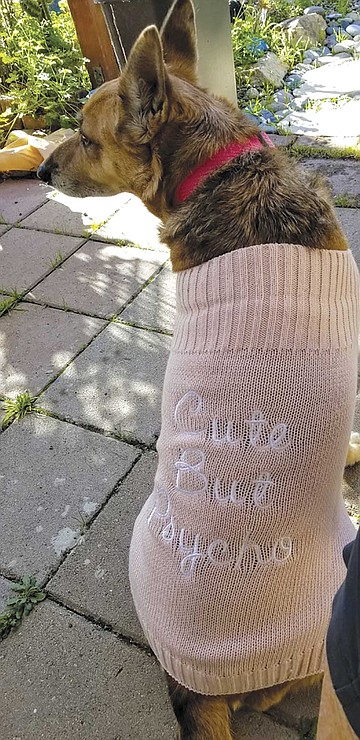
I bought a powder pink sweater for my dog Gypsy. Stitched on it is the phrase “Cute But Psycho” (Chewy, $8 on sale). It’s perfect for my seven-year-old heeler mix, who is both lovable and high strung. However silly it seems, dressing Gypsy brings me joy like nothing else. I knew I couldn’t be the only one who felt this way, so I ventured to find other furry fashionistas.
On a visit to Civita Park in Mission Valley, I met Maybelle and her husband, who are proud parents of two daughters and one six-month-old Pembrook Welsh Corgi. “His name is Sir Biff Wellington, because we like to think of him as a royal pup. He’s royalty, like the Queen’s dog,” she reasoned. “So we like outfits that feature him as regal, or a gentleman, or preppy boy,” she explains.
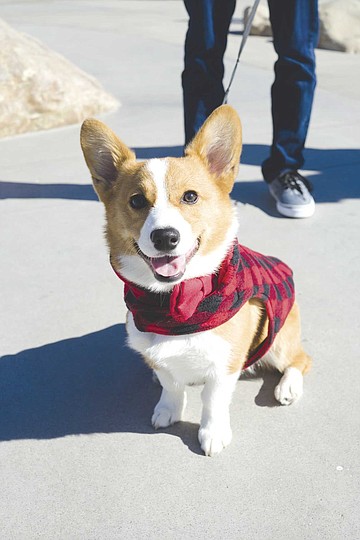
On that day, Biff wore a red plaid flannel coat (ALDI, $9.99) with matching red bowtie. “If we’re going out in public, I do like to dress him up,” she emphasized. Biff roamed at leash length, entirely comfortable. “If he’s out and about, he doesn’t mind the clothes. But if he’s home chilling, he realizes he doesn’t want to be in them.”
Biff has “eight or ten” outfits already, but Maybelle fully intends to add to his wardrobe. “Well, he has his own Instagram (@sirbiffwellington), so that’s why!” She found them for around $8-10 each, shopping at ALDI, H&M, and Marshall’s.
Biff climbed up my leg while I asked Maybelle what could be considered a fashion faux paw (sorry.) “We always joke about the strollers. Although…” she lowered her voice considering, “I don’t know if I’d be too opposed to wearing him in a front pack. If you’re hiking… maybe… I think that also is kind of funny.”
Maybelle continued, “He’s like our third child, you know? He gets just as spoiled as his human sisters. They call him ‘baby brother.’ When we go out, there’s always a consideration to get him something.”
Next, I hit Dusty Rhodes Park in Ocean Beach where I spotted Keri tossing the tennis ball for Charlie. The dog was wearing a red and white stripe cable-knit sweater, a gift from her sisters. The one-year-old Jack Russell Terrier-Chihuahua mix was a rescue from a nonprofit, Tragic to Magic. She explained, “They rescue dogs from Mexico. So they brought him over the border at four months… and we just fell in love with him. Scooped him right up!”
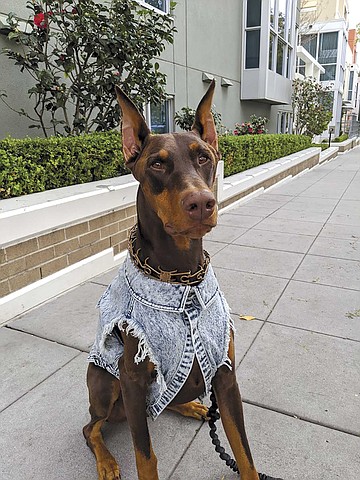
She and her boyfriend also own a couple of cats, but when I asked if she ever dresses them, Keri burst into laughter at the thought. “No! They would never go for that! They would kill me. But Charlie loves it. We have a bubble vest for him when it gets really cold at night. And he has an Adidas hoodie — just, you know, to be cool. And some sweaters when it’s chilly in the mornings. He doesn’t mind at all.” She beamed at him as he trotted back for another throw: “He knows he looks cool!”
Finally, I headed to East Village, where I met Ryan and another Charlie — this time, a three-year-old Doberman Pinscher. Sitting tall, he looked fur-ocious (sorry) in a washed denim jacket (City Dog, $40). Ryan’s tone signaled that it was a splurge, but he still felt the purchase was worth it. I couldn’t disagree. Despite this appearance, Ryan described his pooch’s personality as “totally friendly goofball. He’s just a lover.”
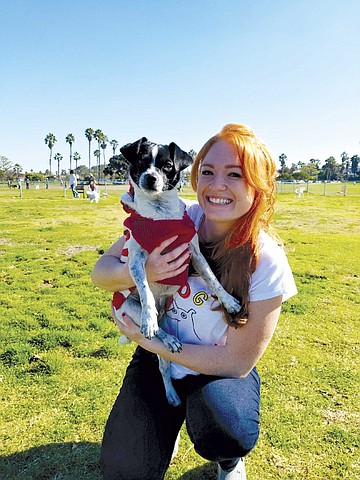
Ryan owns a number of doggy bowties and dresses his Doberman in a sweater to keep him warm on morning walks. “The short hair dogs,” he explains, “they don’t have much to protect them.”
Ryan also thinks it’s good to match collars to a dog’s coat. “It’s sort of bronze, so it really blends in with all of his orangish markings. See how good it looks on him?”
Ryan says Charlie is constantly being approached, “People get really excited! He does have Instagram (@charlie.dobes). He has more followers than me!”
Ryan is aware that some people think dressing dogs is preposterous, but he doesn’t feel judged. “Living downtown, I think a lot of people enjoy dressing their dogs, they just might not have the time to do it. But I think people are pretty open and artsy in this neighborhood.”
– Samantha St. Pierre
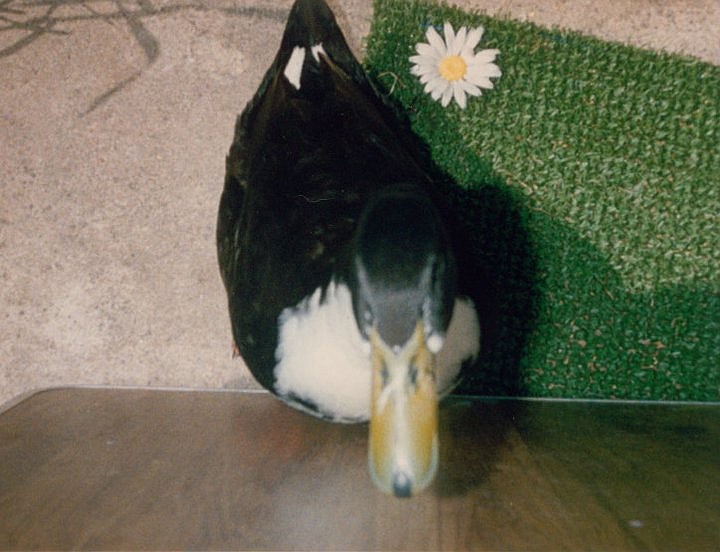
Offbeat and unusual, such friends I've had many,
a lot of odd birds, to be sure.
But perhaps the most odd and offbeat of all
was an abandoned young duck, new to the world.
Heather and I took him into our home,
his namesake a Hobbit named Bilbo,
a name to say slowly when introducing a duck
lest the listener think they've just met a dildo.
Well mannered while young, he'd hold in his poop
while indoors or riding in pockets.
First with peeps, then with quacks, he'd yell to go out,
a habit I missed when he lost it.
An industrious duck, Heather got him a job
selling duck stuff to tourists who met him.
Rode to work in a box on the back of her scooter
(it's not like a helmet would fit him!)
Brave as a lion and fast as a cheetah,
tackling bugs half his size without fear.
A well-travelled duck, though not loved at hotels,
where most said "Get the duck outta here!"
When kittens showed up in his yard with no momma,
he took over and served as their Duck Dad.
They purred and they cuddled to his confident quack,
though the pecking and grooming nearly drove them quite mad.
A land-loving duck, he never did fly,
save for three or four second of lift.
A gardener duck, he ate all the right bugs,
pooping perfect manure he'd present like a gift.
Few lives intersect, not in meaningful ways,
but God blessed me with fortune and luck,
to have shared the most exceptional life
of a most exceptional duck.
— Jay Allen Sanford


My dog has a favorite bar. Loki quickly learned how to navigate the blocks to Hamilton’s Tavern, and if I let her control the leash on our afternoon walks in South Park, that’s where she led me. She even nudges at the door to urge me in for a pint. I’m not sure if that’s a trick I taught her, or the other way around.

When we go inside, people know her, like she’s Norm walking into Cheers. The owner, bartenders, regular customers greet her by name — Loki! —and she reacts to the welcome with excitement. But here’s the weird part: a lot of these people, I don’t know them. Complete strangers often walk toward me, only to crouch down at the last moment to hug and kiss the floppy, fluffy, 40-pound lapdog at my feet. “Loki, darling,” they’ll say, “it’s been too long!”
Turns out, Loki spends more time here than I do. That’s because it’s my ex-girlfriend’s favorite bar, and we agreed to share it when we split up. More importantly, we did the same with the dog. Against sound judgment and the advice of mutual friends, for the past eight years we’ve shared custody of Loki. We pass the pooch back and forth each week. We split costs and health care decisions. And it’s worked out.
Nine years ago, we moved into a dog-friendly rental together, in love and eager to get a puppy. We found a hypo-allergenic wheaten terrier and poodle mix. Loki, named for the dog of mischief, is a charmer. She’s playful and affectionate, and loves to communicate. With her shaggy face, imploring brown eyes, and quizzical head tilts, she usually wants to communicate that whatever you’re doing, she’s in. Whether it’s running around the beach or napping on the couch, she will join you.
That first year, we all lived together happily as Loki’s puppy coat went through the wheaten terrier color changes: starting out dark brown, turning orange, and landing on some shade of wheat. That was about the time our dog-friendly lease ran out, and going month-to-month wasn’t an option. We’d been butting heads on big-picture issues; we weren’t sure we wanted to split up, but we couldn’t commit to another 12-month lease.
We’d each bonded so strongly with the dog, neither would willingly give her up. And neither were we angry enough not to recognize how much we both meant to the dog. Not sharing custody seemed cruel.
So, Loki found herself with two homes, two domains to defend, two front doors to bark at when guests arrive. We fed her the same food and treats, made sure we both had a version of the same favorite toy. The only things that travel back and forth with her are her collar and a leash.
When my ex picks up Loki from my house, Loki will wag her tail and rush out like she’s got somewhere important to be. But when I pick up my dog a week later, she’s just as ecstatic, and leaps into the backseat of my car, ready for the next adventure.
I definitely miss my dog the weeks she’s not around. She’s not there to greet me at the door when I get home, or nuzzled against my feet when I wake up in the morning. She becomes a phantom sidekick I can’t bend down to pet. But there’s an upside. I can leave town for a week, and Loki has no idea. I never have to pay a pet sitter. Loki’s well taken care of, even when I don’t have time.
There have been a few disagreements, but in working together to care for a pet, the Ex and I have managed to remain friends. In fact, when she moved out of her dog-friendly one-bedroom apartment, I moved in. It was almost like Loki got a new roommate.
Our afternoon walks no longer take us to Hamilton’s. Instead, Loki pulls the leash to show me all her favorite pee spots in Golden Hill. And just like that, I learn something new about my dog of nine years. Over hundreds of walks in South Park, she always peed once and was done; she never held any to mark territory along the way. But in Golden Hill she always stops to sniff and mark five specific street corners. As she apparently has for most of her life.
— Ian Anderson

It was late June when I found August — all matted fur and skin and bones. He was in a strip mall parking lot off of Kenwood Drive in Spring Valley. Only a chain link fence separated him from the 94 freeway. A bearded man on a flimsy folding chair outside a nearby smoke shop told me August had been there for over a week. “Someone from the apartment complex across the street dumped him when they moved. It happens. A few people have tried to catch him, but he is slippery,” Bearded explained.
A woman missing a tooth in the center of her smile pulled over when she saw August darting through traffic. Like me, she was concerned.
“He yours?” she asked.
I shook my head, prompting her to stuff two bone-thin fingers into her mouth to whistle in much the same manner as the lunch ladies at my my elementary school did when kids got too rowdy.
“Here puppy! That’s a good doggy,” She cooed in a deep husky voice.
August paused in his tracks, tilted his furry little head, and looked up at her with his sharp auburn eyes before bolting up the street. As he weaved in and out of traffic, I squeezed my eyes shut for fear of witnessing the carnage. Missing Tooth leaned her skinny behind against the hood of her dusty sedan and let out a worried sigh.
“I am not going to panic,” she declared, “He’ll come to me. He won’t got squashed. He will not get squashed!”
Minutes later, August ran a circle around the parking lot. He stopped and looked up at her in an almost taunting manner.
“That’s a good boy,” she cooed.
He came close and sniffed her feet before darting behind a dumpster.
“Get on the other side of that dumpster!” the woman barked, “We can trap him.”
As I moved to one side of the dumpster, I heard from the other, “I got him!” Missing Tooth held August up — a living trophy of her perseverance.
August looked more like a tiny fox than a dog. He was surprisingly docile. He didn’t attempt to wiggle free.
“Feel his little paws,” she said, placing a furry foot into the palm of my hand. It was scorching.
“He has been running so much, I am surprised his little paws didn’t set fire,” the lady added with a soft smile while petting August’s matted fur. His tail was smeared in feces.
She turned to me, adding abruptly, “I can’t keep him. You are going to have to take him,” she pushed the stinky dog into my arms. Noticing my hesitation, she added, “He certainly can’t stay here. He will die! He’s hungry and he’ll get squished. I have four dogs at home. My boyfriend will murder me if I come home with another.”
The man in front of the smoke shop was watching to see what I’d do. I looked at the woman and down at August. He nuzzled sweetly into my shoulder and licked my arm. The woman went over to my car and opened the back door. I set August down, expecting him to run. He didn’t. He jumped into the front seat and nestled down.
“Well, look at that!” she said.
“Free filthy mutt,” the man from the smoke shop yelled with a cackling laugh.
When I pulled out of the parking lot, August climbed onto my lap and looked up at me with sad eyes. I loved him immediately. He needed me. So I took him home and bathed him in my yard until the water running off his fur was no longer brown and his little paws were soft and cool.
— Siobhan Braun

He’s a mysterious looking black feline named Hawke, and he immigrated from Canada a few months ago with his owners, my neighbors. Within days of moving in, they gave all the neighbors a photo of their cats so people would be aware.
Hawke was described as “a bit chubby, but very friendly with everyone,” while the other cat, Edie, “can be frightened a bit easy,” but is “a sucker for cuddles” once she gets to know you.
Hawke is pretty friendly with us, while Edie keeps to herself. Sometimes my wife and I will mention “an Edie sighting.” My wife loves cats, but we haven’t had a pet for a while. Or at least, we didn’t. Remember that part about Hawke being “very friendly with everyone”? Well, he is, but he’s not so good about respecting physical boundaries.
Within a few weeks of being in California, Hawke clawed his way through our back door screen and made himself at home. Now, he comes and goes as he pleases. Somehow, he started sleeping in our bed.
“Can you move over?” my wife will ask me at 2 am.
“Can you tell Hawke?”
“He’s sleeping.”
On the nights when Hawke isn’t here, he will still show up at the back door, politely asking to come in for treats. We bought treats and cat toys. We’re in deep!
Hawke’s boundary issues stretch to the bar separating the kitchen from the dining room. He likes to climb up while we’re making dinner. It’s not always appreciated.
“Hawke’s licking the butter again!”
“Well, get him off the table.”
“I need to scrape off where he was licking.”
The human Canadians are wonderful people who haven’t shown any signs of jealousy, probably because they know we will feed the cats if they go out of town.
Still, I can’t help feeling pangs of guilt, especially when Hawke offers up mice and birds he’s killed as offerings of love.
“Oh my God!” said my son the time Hawke brought a dead dove to the back door.
“Huh?” I asked.
“Look at Hawke!”
And there was the black cat biting off the head of a freshly-killed dove, right before he somehow broke into the breastbone, pulled out the bird’s heart and ate it.
“Wow, nature at work,” I thought.
So I’m not really a cat person, but I’ve heard that you’re supposed to praise them when they bring you dead animals. So there I was, gently lifting the dead bird carcass with the help of a paper towel and walking it to the trashcan on the side of the house while simultaneously buttering up Hawke.
“Oh, you’re such a big killer. Thank you for providing for us. Wow, you really know how to follow those innate feral instincts, don’t you?”
—Patrick Henderson

It wasn’t a promising relationship at first. He was a dog. I hated dogs, though I would never say that out loud. No one is allowed to hate dogs. But my husband Mtume and I did. In public, we said, “We’re not dog people.” To each other we said, “Ugh. I hate dogs. They’re disgusting. Dirty sh*t machines.”
One dog person in my family didn’t seem to understand (or care) about the whole “not dog people” thing, and we had to say no to the pooch every single time said relation came to visit. When you have to keep saying ‘No, please don’t bring your dog,’ you begin to wonder if you’re a bad human. It’s annoying. “Ugh,” Mtume and I would say to each other. “Why do dog people think everyone should love dogs?”
But then my mom got a puppy. A labradoodle she named Beau. When he was about five months old, she asked me to come to Boise to stay with him while she went to her annual five-day silent retreat in the mountains. The way she presented it, she was inviting me to bask in some luxurious me-time at her house, on her dime. All I’d have to do was feed her puppy and take him to the dog park a couple of times. It didn’t sound terrible, so I agreed to do it.
My daughter told me dogs’ eye muscles have evolved to enable expressions that trigger human emotions. I looked it up. It appears to be true. I could certainly feel it working on me. Every morning, I came down the stairs and found Beau at the door of his kennel, looking like Little Mister Perfect with his back straight, “being good” and hoping to be noticed for it. Our eyes locked, and I could feel the serotonin, prolactin, and oxytocin coursing through my bloodstream. There was nothing I could do about it. He made me love him.
He made me love the way his ears flop around. And the way he comes galumphing at full speed toward me at the dog park, only to make a quick, last-second fakeout to the left. He made me love the cooing sound he makes when we play-fight on the living room floor. It’s to be expected, I think, that a person would fall in love with a dog. It’s evolution. But Beau did more than make me love him, he made me love all dogs.
I’m officially dog people now. I stop to pet dogs on the street. I gaze at dogs lovingly from across the park. I applaud dogs in grocery stores and libraries and airports. I sometimes go to Dog Beach just to watch the dogs go bananas in the sand. My mom has a mug that says, “I love dogs. The End.” I want one. The mug, I mean. I want a dog, too, of course. But Mtume says, “Hell no. Not until they make one without an a --hole.”
A plan is in the works, though. Beau is coming for a visit in the spring. He’ll work his magic, and by the time he leaves, Mtume will be dog people, too.
— Elizabeth Salaam

In the fall of 2015, my girlfriend Janelle became ill with what seemed like a nasty case of the flu. After a couple of days of unusually severe symptoms, we took a trip to the ER. The doctors determined that Janelle had pneumonia. The case was bad enough that doctors admitted her for observation overnight. That single night turned into an awful two-week stay that included a dramatic stint in the intensive care unit. She developed a lung disorder known as acute respiratory distress syndrome. After being intubated for a few days, her lungs rebounded.
Her doctors were bewildered as to what could cause a healthy woman in her 30s to fall victim to an illness like that. One theory they came up with was that high stress levels had worn down her immune system. Doctors suggested a variety of stress-relief strategies, one of which would change our lives forever: “Get a pet.”
We had always wanted a dog, but our landlord had a “no pets” policy for our house. So one day, while home on medical leave, Janelle shifted into sales mode and shared her recent plight with our landlord. She explained, with the most earnest of approaches, that a small dog would serve as a sort of semi-service animal for her, highly encouraged by her doctors. A slight increase to our rent was established, and it was a deal.
With ongoing lodging established, the next step was to find the dog. We decided to go the route of rescue, with the assumption that there would be plenty of great dogs looking for their “forever homes.”
We thought it would be a pretty painless process, but adopting a dog was not as simple as going to the local shelter, paying a small fee and taking home a new Fido. For us, dog-adoption involved intensive research, application fees, interviews, competition, and even some initial heartbreak.
Truth be told, we were a bit picky. We both wanted one of those fluffy little dogs, probably some hypoallergenic poodle mix. There were a decent number of them out there, but we weren’t aware of just how many other people were searching the same sites for the same little critters.
After lots of online research and several adoption events, we thought we had found our match when we drove to Clairemont to meet Bailey, a 10-month-old poodle mix Janelle had been eyeing. Bailey had a charming personality and seemed like the perfect object of our love and affection.
There was another woman angling for Bailey, though, and as the morning progressed, she became our archnemesis. At this event, the dogs were available on a first-come, first-served basis, assuming you had the necessary cash. We had arrived early for this exact reason, but the nemesis claimed that she had been there first and essentially latched herself onto the dog — our dog! The nerve. The nemesis’ strategy paid off, and Janelle cried all the way home in the car.
We licked our wounds and continued to search for the perfect pooch.
Soon thereafter, we discovered another adorable ball of fluff on the interwebs. His name was Palmer, and he was currently under the care of foster parents in Orange County. We stalked Palmer online for a spell before we drove to a Petco in Newport Beach for an adoption event. It turned out to be more of a job interview where we had to explain why we would be the perfect pet parents to our dog of choice.
Palmer was just what we were looking for. He was loving, kind, hypoallergenic, and constantly insisted on being picked up and hugged. Bingo!
The issue was that a small child seemed similarly attached to Palmer. I considered roughing up the kid but restrained myself. A couple of days later, we got the call that Palmer was ours. Janelle’s work-from-home gig had sealed the deal, as the five-year-old pooch was apparently a bit on the needy side.
Palmer arrived and was promptly rebranded Georgie Ruff Ruff Martin — a name inspired by my late mother’s devotion to Game Of Thrones.
Georgie has been a loyal dog at our sides and in our bed for nearly four years now. We had no idea how much love we could feel for a fuzzy little buddy. Much like new parents, we can’t even remember what we talked about before he came into our universe. He was a big hit at our wedding a couple years later as well.
Georgie continues to follow us from room to room in the house, and he’s doing his part to keep Janelle’s stress levels low and her lungs healthy.
— Dryw Keltz

“I’m not sure if they’re even still alive,” Cassie Youngborg said with concern as we walked in her front door. “They haven’t come out since late October.” Cassie’s four pet desert tortoises began their first brumation — similar to hibernation, but for cold-blooded animals — in late autumn 2019; they were still a bit young to exhibit the behavior. We were there to watch them wake up.
Cassie was surprised when the three-and-half-year-old tortoises started digging themselves under the loose dirt in their plywood pen, which she keeps in the sunny front room of her Encinitas home. She consulted her tortoise-keeping pals and they advised her to go with it. So she and her husband built a makeshift burrow of cardboard to keep the young tortoises covered.
Desert tortoises usually begin brumation around age five, when they’re juveniles. Younglings might be too small to maintain body weight for the prolonged rest period. During winter months, certain reptiles drop body temperature and go into a state of torpor until the weather warms up. Unlike mammal hibernation, brumation is not sleep. Tortoises might come out to drink water — though Cherepaha, Rùa, Gui, and Lock Posht (that’s Russian, Vietnamese, Mandarin, and Arabic for turtle) didn’t emerge at all during their first brumation.
Cassie’s four desert tortoises hatched under the care of her friend, Marcel Van Boxtel, whose 45-year-old pair, Taco and Tequila, produce 12-14 eggs every year. She took them home right away and began caring for them as pets, along with her now 37-year-old yellow-naped Amazon parrot and a black lab. Desert tortoises are endangered in the wild, and it is illegal to take one out of the desert, buy, or sell one. It is, however, legal to keep them as pets in California, with a special permit, as long as they are descended from animals that were in captivity before 1990. The San Diego Turtle and Tortoise Society can help with care tips and paperwork.
Cassie’s grandmother Prudence also raised pet turtles at her home in Del Mar. She put a sign on the fence advertising “25¢ a snail.” Neighborhood kids got a quarter for every snail they brought for her tortoises to eat.
“I’ve missed you,” Cassie cooed to the little tortoises as she reached into the burrow to unearth them one by one. They looked healthy. Their shells ranged in size from about six to eight inches. She placed all of them around the pen and sprinkled some fresh lettuce leaves. To our surprise, the first one poked its little head out after just a few seconds.
“Are you hungry? You probably want a drink!” Cassie hurried to put their water dish in the pen and pour in some warm water she had prepared. She picked one up and placed it directly in the dish. As it soaked, the tortoise dipped its head and began to sip. Warm water helps restore body temperature. Cassie gives them spring water or filtered water.
“Now your sister wants a turn.” She put the smallest of the four in the dish. “She has a little underbite,” Cassie pointed out. “She’s the only turtle I’ve seen like that.”
“Hello!” Bob the parrot called from his enclosure in the next room. “Errol, what’re you doing to your brother?!”
Errol is one of the Youngborgs’ children, now adults and moved out. Bob the parrot grew up with them and of course picked up the family chatter. He reminded us of his presence every few minutes with a snappy phrase.
“Hey, baby!”
Outdoors in the front garden, more life flourished. Fat monarch caterpillars munched on milkweed. Cassie grabbed a few leaves of arugula and ate them. She showed us a mature lemongrass plant and feverfew that she chews when she gets a headache.
When we went back inside to check on the tortoises, three of them were favoring one corner of the pen. They looked like they wanted to hide. Cassie rested a blanket over the corner to form a dark place. Sure enough they all crawled under.
“I sing this song when I go to schools to teach the kids about turtles,” she shared as she put her hand into a turtle puppet. “When I get tired, I pull in my head, I pull in my head, and I go to bed.”
— Leorah Gavidor

Janice Jordan’s passion is the welfare of her animals. This much becomes clear as we tour her 3.5-acre ranch in the Pauma Valley, about 40 miles northeast of downtown San Diego, where I meet dogs, cats, birds, goats, horses, turtles, ducks, a potbellied pig (Piggie Smalls), a full-sized, half-blind farm pig (Champ), and a pair of wolf dogs.
“We’re an all-species, special-needs animal rescue,” explains Friends of Ferdinand co-director Jordan. “We’re the go-to agency when there’s a special-needs animal, including a puppy we have right now with mega-esophagus, a condition that means he needs to be held upright when he is fed. We work with blind animals, deaf animals, geriatric animals, animals who are missing limbs, ‘attitude animals,’ and others who are just not being adopted.
“We take on anything that humane societies cannot take care of in a shelter. When it comes to special needs, I don’t want people to think just of extremely hard cases where an animal is born without limbs or eyes; the term can encompass any animal that a traditional shelter doesn’t deem adoptable.”
A co-founder of Ferdinand’s Familia, another all-species rescue based in San Diego, Jordan branched off to form Friends of Ferdinand to care for animals needing more specialized or long-term care.
Most of the property’s pens, fenced yards, and other enclosures are home to more than one type of animal. Ducks and turtles share a shady pen surrounded by a stand of trees, while Piggie Smalls is accompanied in his corral by a pair of inquisitive goats and an older horse who seems uninterested in human company.
“When an animal comes to us, they’re immediately introduced to other species. If they’re able to get along with others, that makes them immensely more adoptable, while the ones with the highest euthanasia rates are those who can’t interact with other animals,” Jordan explains. “So here you’ll see the tortoises are with the pigs, the cats interact with dogs, and sometimes birds and rabbits. It makes them more sociable.”
Still, Jordan admits that finding the right adoptive home for an animal with special needs, whether they be issues pertaining to limited mobility, sight problems, or a condition that requires regular medication, is harder than placing a puppy or kitten with a family.
“What I’ve learned is that we really have to work to find the perfect pairing,” Jordan continues. “Most people want an animal that’s not high maintenance. So needing to provide regular medicine, or deal with seizures, or even with an animal that’s just hyperactive and needs a lot of interaction and walks — I wouldn’t push anyone who’s not prepared to take that on.”
— Dave Rice
When it comes to pets, the lion’s share of attention tends to gravitate toward dogs and cats. Smaller furry companions are often easy to overlook.
Likewise, the storefront for Wee Companions — an animal rescue dedicated to small animals such as guinea pigs, rats, mice, hamsters, and chinchillas — is easy to miss. It’s tucked into the back of a University City strip mall between Sprouts and a post office. It takes a moment to locate the entrance after Fenella Speece, the organization’s president, invites me to come by and learn more about the charges under her care.
Speece, a petite, bespectacled Englishwoman, grew up raising guinea pigs before parting with her pets to attend university. Years later, she landed in San Diego as a Navy wife with two children and rekindled her love for small animals after noticing a lone guinea pig at a dog adoption event in Balboa Park.
After learning that rescue options for small pets were limited around the county, she began growing a network of volunteers, and in 2003, she formed Wee Companions. Today, as many as 250 animals are in foster care at any given point in time, with the group facilitating between 1000 and 1200 adoptions annually.
Their goal is to eventually fund a full-time shelter serving small animals exclusively, but for now, the shop is open Saturdays and Wednesday afternoons, when volunteers bring in foster animals to meet potential adoptive families. The space also sells food, toys, and bedding, along with other small pet necessities, while an adjacent property hosts Monte’s Corner, a secondhand shop named after a favorite foster guinea pig, that provides a fundraising avenue to the group.
“People can come in as many times as they want; I love to see that,” Speece says. “They bring their child, handle a guinea pig, then say they’ll be back the next week to meet some more animals. They’re on the hunt for a pet, but they’re taking the time to find the right one.”
“Small animals can be seen as easily disposable animals, and believe it or not, we’ve found them abandoned by dumpsters, in dumpsters, by the pet stores that they were originally purchased from and which can’t take them back,” Speece continues. “The most heartbreaking thing I hear is that small pets are used as ‘starter’ pets. ‘Let’s see if the kids do well, and if they do, then we’ll graduate up to a puppy.’
“Allergies are also an issue — Timothy hay, a type of grass, is a primary component in many small animals’ diet. To ensure a fit, adoptees are sent home with a bundle of hay — to expose not only themselves but other family members — to ensure there are no reactions that might lead to problems post-adoption.”
— Dave Rice

Since I adopted my cat in early 2014, I have been going to the same veterinarian in Tijuana. I adopted “Bisho” through my friend Claudia. She would not give me the kitten unless I promised I would have him neutered and bring him to a vet regularly. She recommended Servicio Veterinario California in downtown Tijuana, and told me to mention the kitten was a rescue to get a discount.
The cost of neutering Mr. Andrew Meowricio Pollock Bisholino II (that’s his full name) was 300 pesos, the discount brought it down to 200 pesos (around $11 USD). I was also provided with a “pet passport” noting his vaccinations and that he was fixed.
The veterinary office is located in Calle Tercera near Parque Teniente Guerrero. A tiny yellow front desk area decorated with several animal figurines also serves as a waiting room and is usually packed with people holding small dogs. People with bigger dogs wait outside. A mixture of barking and meowing fills the air, as well as the chatter in Spanish, English, and Spanglish. The smell is musky and not very pleasant. A handful of veterinarians and assistants move from room to room, doing everything from handling the pets and answering the phone to responding to clients impatiently waiting for their turn.
It’s chaotic, but worth the wait.
“Unconsciously, I like to help people, even when I don’t want to. It is in my nature,” says César Wilfredo Solórzano. Dr. César has run Servicio Veterinario California since 2005. The small clinic sees around 50 animals per day, mostly cats and dogs.
“I just gave back a dog that fractured his hip. The cost was 12,000 pesos with X-rays and two days hospitalized, but the owner bought his own meds. In the States, just the X-rays could be $1000. It’s expensive over there because everything is expensive over there.”
If my cat breaks its leg or something similar, Dr. César tells me it’s between $250-350, depending on the size of the fracture and the cat. Vaccinations and consultations are so cheap that I don’t worry about it (I have not spent more than $20).
It’s not only the price that makes my veterinarian great. He handles my cat nonchalantly and forces his mouth open as if it’s nothing. Bisho is not a cat that likes to be handled by strangers. “The clinic started humbly, with just one exploration table and a small locker for medicine. It has grown a lot in equipment and staff. There are now two more doctors who both developed under me.”
Dr. César graduated from the university of his home state of Nayarit in 1996, joined an experimental investigation camp, and then got his Masters degree in Reproductive Sciences from UNAM (Mexico’s highest-ranked university) in 2004. He had a segment on the local channel (TVAzteca) where he handled all kinds of pets.
“For the TV segment, I had to read a lot. I learned about small exotic animals like rabbits, snakes, turtles, and more. I know more about handling them, proper cage temperatures, type of food, and I can give advice to people on proper care. If it’s for a medical procedure, I refer them to colleagues that specialize in them.”
The veterinary clinic is what in Mexico they call the “BBB”: bueno, bonito, y barato (good, pretty, and cheap).
— Matthew Suarez

I bought a powder pink sweater for my dog Gypsy. Stitched on it is the phrase “Cute But Psycho” (Chewy, $8 on sale). It’s perfect for my seven-year-old heeler mix, who is both lovable and high strung. However silly it seems, dressing Gypsy brings me joy like nothing else. I knew I couldn’t be the only one who felt this way, so I ventured to find other furry fashionistas.
On a visit to Civita Park in Mission Valley, I met Maybelle and her husband, who are proud parents of two daughters and one six-month-old Pembrook Welsh Corgi. “His name is Sir Biff Wellington, because we like to think of him as a royal pup. He’s royalty, like the Queen’s dog,” she reasoned. “So we like outfits that feature him as regal, or a gentleman, or preppy boy,” she explains.

On that day, Biff wore a red plaid flannel coat (ALDI, $9.99) with matching red bowtie. “If we’re going out in public, I do like to dress him up,” she emphasized. Biff roamed at leash length, entirely comfortable. “If he’s out and about, he doesn’t mind the clothes. But if he’s home chilling, he realizes he doesn’t want to be in them.”
Biff has “eight or ten” outfits already, but Maybelle fully intends to add to his wardrobe. “Well, he has his own Instagram (@sirbiffwellington), so that’s why!” She found them for around $8-10 each, shopping at ALDI, H&M, and Marshall’s.
Biff climbed up my leg while I asked Maybelle what could be considered a fashion faux paw (sorry.) “We always joke about the strollers. Although…” she lowered her voice considering, “I don’t know if I’d be too opposed to wearing him in a front pack. If you’re hiking… maybe… I think that also is kind of funny.”
Maybelle continued, “He’s like our third child, you know? He gets just as spoiled as his human sisters. They call him ‘baby brother.’ When we go out, there’s always a consideration to get him something.”
Next, I hit Dusty Rhodes Park in Ocean Beach where I spotted Keri tossing the tennis ball for Charlie. The dog was wearing a red and white stripe cable-knit sweater, a gift from her sisters. The one-year-old Jack Russell Terrier-Chihuahua mix was a rescue from a nonprofit, Tragic to Magic. She explained, “They rescue dogs from Mexico. So they brought him over the border at four months… and we just fell in love with him. Scooped him right up!”

She and her boyfriend also own a couple of cats, but when I asked if she ever dresses them, Keri burst into laughter at the thought. “No! They would never go for that! They would kill me. But Charlie loves it. We have a bubble vest for him when it gets really cold at night. And he has an Adidas hoodie — just, you know, to be cool. And some sweaters when it’s chilly in the mornings. He doesn’t mind at all.” She beamed at him as he trotted back for another throw: “He knows he looks cool!”
Finally, I headed to East Village, where I met Ryan and another Charlie — this time, a three-year-old Doberman Pinscher. Sitting tall, he looked fur-ocious (sorry) in a washed denim jacket (City Dog, $40). Ryan’s tone signaled that it was a splurge, but he still felt the purchase was worth it. I couldn’t disagree. Despite this appearance, Ryan described his pooch’s personality as “totally friendly goofball. He’s just a lover.”

Ryan owns a number of doggy bowties and dresses his Doberman in a sweater to keep him warm on morning walks. “The short hair dogs,” he explains, “they don’t have much to protect them.”
Ryan also thinks it’s good to match collars to a dog’s coat. “It’s sort of bronze, so it really blends in with all of his orangish markings. See how good it looks on him?”
Ryan says Charlie is constantly being approached, “People get really excited! He does have Instagram (@charlie.dobes). He has more followers than me!”
Ryan is aware that some people think dressing dogs is preposterous, but he doesn’t feel judged. “Living downtown, I think a lot of people enjoy dressing their dogs, they just might not have the time to do it. But I think people are pretty open and artsy in this neighborhood.”
– Samantha St. Pierre

Offbeat and unusual, such friends I've had many,
a lot of odd birds, to be sure.
But perhaps the most odd and offbeat of all
was an abandoned young duck, new to the world.
Heather and I took him into our home,
his namesake a Hobbit named Bilbo,
a name to say slowly when introducing a duck
lest the listener think they've just met a dildo.
Well mannered while young, he'd hold in his poop
while indoors or riding in pockets.
First with peeps, then with quacks, he'd yell to go out,
a habit I missed when he lost it.
An industrious duck, Heather got him a job
selling duck stuff to tourists who met him.
Rode to work in a box on the back of her scooter
(it's not like a helmet would fit him!)
Brave as a lion and fast as a cheetah,
tackling bugs half his size without fear.
A well-travelled duck, though not loved at hotels,
where most said "Get the duck outta here!"
When kittens showed up in his yard with no momma,
he took over and served as their Duck Dad.
They purred and they cuddled to his confident quack,
though the pecking and grooming nearly drove them quite mad.
A land-loving duck, he never did fly,
save for three or four second of lift.
A gardener duck, he ate all the right bugs,
pooping perfect manure he'd present like a gift.
Few lives intersect, not in meaningful ways,
but God blessed me with fortune and luck,
to have shared the most exceptional life
of a most exceptional duck.
— Jay Allen Sanford
Comments